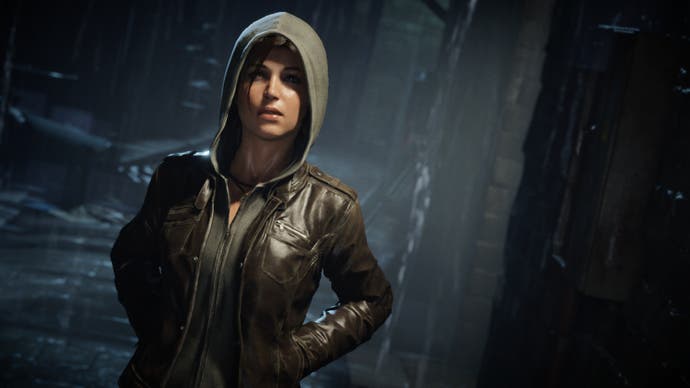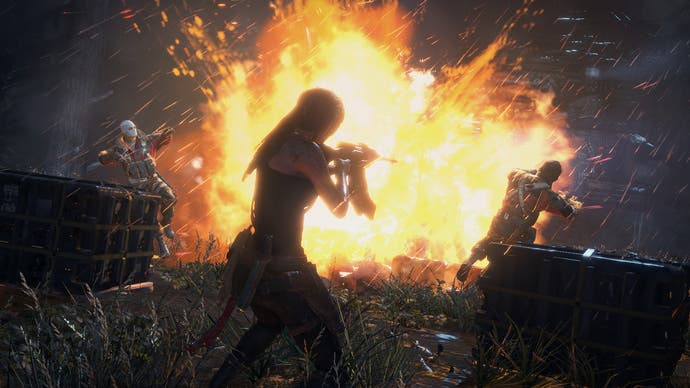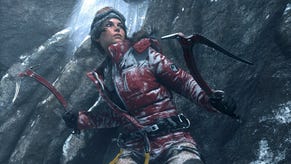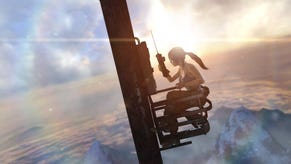Rise of the Tomb Raider review
Plunder the influence.
It is, if nothing else, a hell of a title. Rise of the Tomb Raider: it's got that hint of pulp-magazine shlock, of the lurid, post-colonial adventures of the class of fictional explorers and action-archeologists to whom Lara Croft owes so much.
It works on other levels, too. Her last game, 2013's Tomb Raider, reset the clock and cast Lara as a vulnerable ingenue learning the strength and resourcefulness - and ruthlessness - that she would need to become a hero. It was a jarring gearshift for a character whose previous incarnation was a remote, ice-cool badass, and her personal struggle clashed with the violence of the gameplay. But, as a narrative device on its own terms, it worked. And now that title promises the pay-off: the rise and rise of New Lara as the finished article, the Tomb Raider, the swan-diving, rock-climbing, gun-toting woman of our dreams.
It only half-delivers. Even as Rise of the Tomb Raider's lightweight but sturdy framework for character development propels Lara to a capability her former self would have envied - survivalist, commando, craftswoman, fluent in ancient Mongolian and able to lethally overpower warriors twice her size - its storyline arrests her development. Developer Crystal Dynamics serves a preposterous yarn about a lost civilisation in the Siberian wilderness with a sombre straight face, saddling our heroine with obsessive daddy issues to work through. It's a game with a bad case of second-act syndrome. The Tomb Raider's rise might have to wait until after therapy.
The set-up is straight from any previous Tomb Raider or, for that matter, any Uncharted: Lara's on the trail of an ancient artifact of mystical power, said to bestow eternal life and reside in a legendary lost city. (Traditions are all well and good, but this genre could probably use a narrative shake-up.) The trail was laid by her father, whose claims about the artifact, a deathless prophet, and a centuries-old evil secret society called Trinity earned him public ridicule and might have caused his death. Spoilers: they're all true. Lara is thus furnished with a MacGuffin to chase, an army of sinister goons to murder, an extremely unconvincing lost tribe to ally with, and a motivation to privately brood over.

It's pretty silly stuff, but the real trouble is the excess of gravitas and lack of zest in Rhianna Pratchett's script and in Camilla Luddington's performance as Lara. Luddington delivers her lines in a breathy, reverent drawl, with a laboured seriousness, rarely allowing an edge of humour or steel into her voice. (I recently played all three Uncharted games and, though their plots are just as flimsy and their gameplay more basic, I found myself missing their levity and sense of romance.) Whether or not you agree with the direction Crystal Dynamics and Pratchett took Lara in three years ago, it at least moved her toward a three-dimensional humanity. Rise of the Tomb Raider keeps the tone but skimps on the character work, rendering her flat: a cut-price Katniss Everdeen, bow over one shoulder, chip on the other. If the imperious, almost callous James Bond vibe of the old Lara is ever to make a comeback, it won't be this time. The cut-glass accent is about the only thing that's left.
In action, though, this Lara means business. Crystal Dynamics' artists give her a compact frame, well shod and practically dressed, and lavish detail on the tools of her trade: the customised pistol hanging from her belt, the hand-crafted quiver, the reinforced climbing axes. The animators give her determination, smooth precision and power, and humanity too in the way she wrings out her ponytail when she climbs out of water. This is a woman of ability and purpose. Aggression, too - she attacks with a bloodthirsty ferocity that's off-putting, if perhaps necessary to sell the idea of a slender five-footer taking down an armoured hulk with a single blow. This incarnation of Tomb Raider still seems more violent than it needs to be.

The gameplay mix will be familiar from the 2013 game, though it's better blended and balanced. The main thrust of the action borrows (or perhaps, collects a debt) from Uncharted, moving between climbing, combat, light puzzle-solving and set-piece spectacle with smooth sweeps of a cinematic camera, but toning down Naughty Dog's taste for the outrageous. This linear rush is then set within something broader and a bit more substantial: along the route, a handful of large areas open up, garnished with the side missions, checkbox challenges, collectables and secrets of an open-world game. There's a lite role-playing game in here, too. Everything grants XP towards unlocking skills, and the stunted crafting system of the last game finds full expression, allowing Lara to craft useful items on the run as well as improve her equipment at camp.
It's an unchallenging pot-pourri of virtually every current mainstream gaming fashion, bearing the clear imprimatur of design by committee. But Crystal Dynamics is too experienced and talented a studio to let it get incoherent or unfocused. Whether serving up stealth combat or skill trees, the game is never less than cleanly competent, and often enough it's compelling. Lara's advancement path is very satisfying, with skills that offer more tangible and useful perks than many a full-blooded RPG (I'm looking at you, Geralt), mated to Zelda's equipment unlocks and The Last of Us' weapon modification. It's in the quick strides Lara takes towards her final form as an intoxicating Swiss army knife of an action hero that Rise of the Tomb Raider earns its title.

Nevertheless - and as fans will surely have predicted - it's when the game simply remembers to be Tomb Raider that it's at its best. In nine optional Challenge Tombs and at a couple of junctures in the story, Lara finds herself gingerly exploring lonely ruins, gorgeous in their centuries-old decay. Here she solves cleverly assembled, if relatively simple, physics puzzles to gain access to a treasure trove. (In this game, the treasures are new skills - the designers clearly knew what they were getting right.) Quiet descends, all the firefights and resource nodes and progress tickers recede, and the game drinks from a well too few contemporaries bother to seek out. Just a woman and her wit, unlocking the secrets of the distant past.
It's not the lip-service the 2013 game paid to the tomb-raiding concept, but it's still barely more than a sideline for nouveau Tomb Raider. Given the tombs' strong flavour and Crystal Dynamics' comfortable command of the form, why couldn't there have been more of them, with harder puzzles, and why couldn't they have occupied some of the space filled with empty battles and vacant scrambles in the storyline? Was it a lack of corporate confidence or a surfeit of bitter experience that led to tomb raiding taking a back seat? I'm not sure I want to know the answer.
Either way, it's emblematic of a series that's suffering an identity crisis - trying too hard to be all things to all men, and not hard enough to be itself. Perhaps you can extend that identity crisis to the whole genre of action-adventure. Once the primary form of blockbuster game, these mass-market single-player capers are now judged too narrow in scope, insufficiently social and connected and customisable, to be really big. Hence Rise of the Tomb Raider's faux-open-world feature creep - and hence Expeditions.
Expeditions replace the last game's aimless multiplayer mode, and on paper, they're a better fit. A variety of game modes allow you to replay chapters or revisit areas from the main game, with additional challenge goals and online score leaderboards. The kicker? Expedition cards. These come in blind packs, bought either with credits earned in-game or with real money. They modify the gameplay or Lara's loadout for each run, with appropriate penalties or bonuses to your credit rewards from the mission.

There's the potential for a fun afterlife for the game in Expeditions. The Score Attack mode - a time-attack variant which adds score combo chains and custom challenges to every chapter of the game - can be an enjoyable test once you've picked your way through the confusing maze of variables and figured out which ones best fit the level in question. Chapter Replay Elite allows you to to carry your skills and equipment from the campaign into any level, and will have to do in lieu of the New Game Plus mode that Rise of the Tomb Raider is begging for. Remnant Resistance, which allows you to share custom missions with other players, is rather slapdash. All of them could have worked just as well - arguably better - without those modish card packs. Over-egged and undercooked, running in some desperation after the FIFA Ultimate Team and Hearthstone bandwagons, Expeditions is a blatant play for YouTube relevance and micro-transaction revenue. It has no pressing reason of its own to exist.
Can Tomb Raider, and by extension any modern action-adventure game, really not survive without some extraneous lunge for life after the credits roll? Is it too old-fashioned? Just too expensive to make? Rise of the Tomb Raider is a well-made game. It's a handsome and solidly entertaining, if seldom inspired, way to while away a dozen hours. It has a famous name and an avatar of real dynamic power at its centre. It has tombs to raid. That ought to be enough. It shouldn't have to reach. But reach it does - for an emotional hook it doesn't have, and for trendy gimmicks it doesn't need.
If you've come unstuck in the game, our Rise of the Tomb Raider guide is live now.



.png?width=291&height=164&fit=crop&quality=80&format=jpg&auto=webp)












